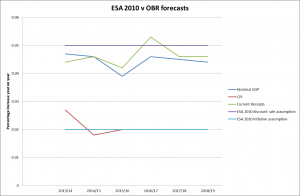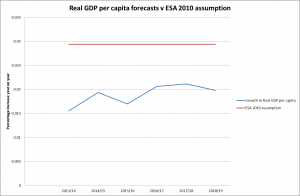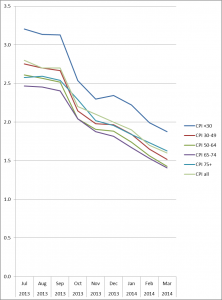I have been reading Ha-Joon Chang’s excellent book Economics: The User’s Guide after listening to him summarising its thrust at this year’s Hay-on-Wye Festival of Literature and the Arts. It is very disarming to meet an economist who immediately tells you never to trust an economist, and I will probably return to his thoughts on the limitations of expert judgement in a future article.
But today I want to focus on his summary of the major schools of thought in economics, and what the implications might be for actuaries. Chang’s approach is that he does not completely subscribe to any particular school but does not reject any either. He bemoans what he sees as the total domination of all economic discussion currently (and therefore also all political discussion about running the economy) by neoclassical economists. I think actuarial discussion may suffer from a similar problem.
So what is neoclassical economics? Well it has become almost invisible to us due to its omnipresence, in the way fish don’t see the water they swim in, but its assumptions may surprise you. It assumes that all economic decisions are at an individual level, with each individual seeking to maximise what is known as their utility (ie things and experiences they value). The idea is that we self-interested individuals will collectively make decisions which, within the competitive markets we have set up, result in a socially better outcome than trying to plan everything. This approach has become a very conservative outlook (ie interested in preserving the status quo) in Chang’s view ever since it was further developed to include the Pareto principle in the early 20th century, which says that no change in economic organisation should take place unless no one is made worse off. This limits the scope for redistribution within a society, which can lead to the levels of inequality we see now in parts of the developed world which many are becoming increasingly concerned about, Thomas Piketty included.
Arguments between neoclassical economists in Chang’s view tend to be restricted to ones about how well the market actually works. The market failure argument says that there is a role to play for governments in using taxes and regulations (negative externalities) or in funding particular things like research (positive externalities) to mitigate the impacts of markets, particularly in areas where market prices do not fully reflect the social cost of particular activities (eg pollution on the environment). Another criticism made of neoclassical economics is that it does not allow properly for the fact that buyers and sellers do not have the same level of information available to them in many markets, and therefore the price struck is often not the one which would lead to the best outcome for society as a whole. So the more “left wing” neoclassicalism requires more market regulation to protect consumers and the environment they live in.
The more “right wing” neoclassical response to this is that people actually do know what they are doing, and even build in the likelihood that they are being conned due to asymmetric information in the decisions they make. The government should therefore reduce regulation and generally get out of the way of wealth-creating business. This form of neoclassicalism views the risk of government failure as much greater than that of market failure, ie even if we have market failure, the costs of government mistakes will inevitably be much greater.
And if you draw a line between those two forms of neoclassicalism, somewhere along that line you will find all of the main UK political parties and pretty much all economic discussion within the financial services industry.
And, on the whole, it tends to circumscribe the role that actuaries play in the UK.
One of the major drawbacks of neoclassical theory is that is assumes risks can be fully quantified if we only have a comprehensive enough model. Actuaries are predominantly hierarchists, who believe that they can manage the inequalities which flow from neoclassical theory via collectivist approaches, like insurance policies and pension schemes, and protect individuals and indeed whole financial systems from risk. Since Nicholas Nassim Taleb and others made so much money from realising that this was not the case in 2008, this has probably been neoclassicalism’s most obvious flaw, and the one which has given rise to the most discussion (although possibly not so much change to practice) amongst actuaries.
But there are others. Neoclassicalism assumes that individuals are selfish and rational, both of which have been persuasively called into question by the work of Kahneman and others, who have shown that we are only rational within bounds and make most of our decisions through “heuristics” or rules of thumb. Actuaries have tried to reflect these views, some of which were originally developed by Herbert Simon in the 40s and 50s, particularly in the way that information is communicated (eg the recent publication from the Defined Ambition working group), but have very much stayed at the microeconomic level (very much, according to Chang, like much of the Behaviouralist School themselves) rather than exploring the implications of this theory at a macroeconomic level.
Neoclassical theory is also much more focused on consumption than production, with its endless focus on markets of consumers. One alternative approach is that proposed by the Neo-Schumpeterian School, which rightly points out that, in many markets, technological innovation is considerably more important than price competition for economic development. The life-cycle of the iphone, from innovation to temporary market monopoly to the creation of a totally new market in android phones is a case in point. Actuaries have done relatively little work with technology firms.
Another school of economic thought which is much more focused on production is the Developmentalist Tradition, which believes governments can improve outcomes considerably by intervening in how economies operate: from promoting industries which are particularly well-linked to other industries; to the protection of industries which develop the productive capability of the economy, particularly infant industries which might get smothered at birth by the more established players in the market. This tradition clearly believes that the risk of government failure is less than the potential benefits of intervention. The failure of productivity to pick up in the UK since 2008 has been described as a “puzzle” by the Bank of England and other financial commentators. Perhaps some clues might lie outside a neoclassical viewpoint.
The Institutionalists have looked at market transaction costs themselves, pointing out that these extend way beyond the costs of production, and could theoretically encompass all the costs of running the economic system within which the transactions take place, from the courts to the police to the educational and political institutions. They have suggested that this may be why so much economic activity does not take place in markets at all, but within firms. I think actuaries have started to engage with failures in pricing mechanisms recently, particularly where these have environmental consequences such as in the case of carbon pollution and the implications for the long term valuations of fossil fuel reserves on stock markets.
The Keynesians I have written about before. They are probably the most opposed to the current austerity policies, pointing out how, if a whole economy stops spending and starts saving when in debt, as an individual would, the economy will stay in recession longer and recovery (and therefore the possibility of significant deficit reduction) will be slower. The coalition government in the UK have neatly proved this point since 2010.
I could go on, about the Classical or Marxist Schools which have been largely discredited by historical developments over the last 200 years, but which still have useful analysis of aspects of economics, or the spontaneous order of the markets believed in by the Austrian School. However my point is that I think Chang is right to highlight that there is a wider range of economic ideas out there. Actuaries need to engage with them all.


















